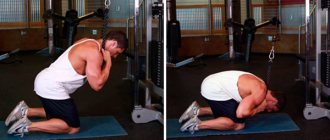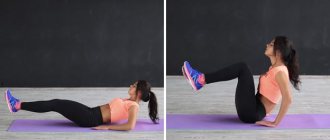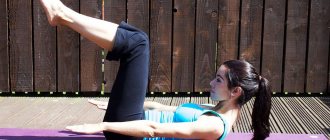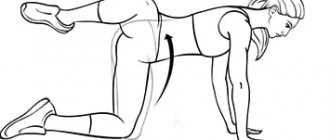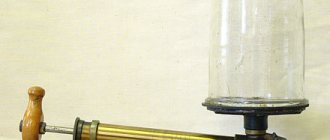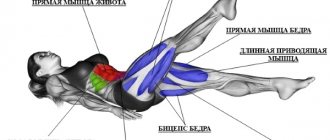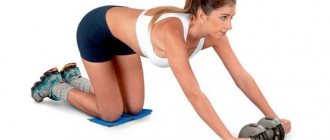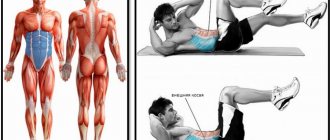What is a belly vacuum
Abdominal vacuum is a specific set of training aimed at strengthening the anterior abdominal wall and reducing waist size. This uses all the abdominal muscles. The technique is borrowed from yoga and is used by beginners and professional athletes.
As a result, you can remove excess volume, strengthen not only the abdominals, but also the entire muscular corset responsible for maintaining the spinal column.
"Vacuum" for the stomach "Sitting"
It is complicated by the involvement of the spinal muscles. It should be performed on a hard surface, if it is a chair, do not lean against a support, put your hands on your knees, place your legs at right angles, your chin should look down without pressing to your chest. Having taken the starting position, we perform the same breathing technique:
- release air;
- tighten the stomach;
- hold our breath;
- rest and then repeat 5 times.
To avoid the temptation to lean back in your chair, it is better to use a stool, but a stable one. The “Vacuum” exercise for the abdomen, according to reviews, gives good results and quite quickly. The main thing is to follow the instructions.
Mechanism of weight loss
The internal and external muscles, as well as the rectus muscles, starting at the end of the sternum and ending in the area of the pubic bones, are responsible for the formation of relief. In addition, there are oblique abdominal muscles that respond to waist size.
If a person devotes a lot of time to training, but the oblique muscles are not used, fat accumulates in the sides and lower back. When using the abdominal vacuum technique, all muscle groups are involved, which ensures an even load and eliminates the fat layer.
Additionally, during training, a special breathing technique is used, which involves saturating the body with oxygen after a short-term fast. In this case, intensive energy consumption and burning of fat cells occurs. Thanks to this effect, you can notice the first results within a short period.
Rules for sports training
- No matter how effective and highly effective your training is, everything will turn to dust if you do not adhere to a special menu in the complex. Remember! Physical activity burns calories well, but if you take in more calories from food than are eliminated during exercise, you will not be able to lose weight. There is no need to complicate your life by playing sports; eat a varied, but healthy diet.
- You need to conduct from 2 to 4 workouts per week, each of which should last at least half an hour.
- During exercise, your breathing and heartbeat should be rapid - when burning fat reserves, it cannot be otherwise.
- The amount of excess weight lost per month is purely individual; before you start systematically exercising, take measurements of your volumes and record the parameters.
- You need to train over several months, so you don’t need to speed up and make your training too long and intense. Do not give in to fanaticism, and then you will certainly succeed!
- To avoid poor posture, alternately perform exercises for different muscle groups.
You should not automatically repeat the exercises; it is best to visualize everything that happens during the next exercise, which muscles contract and which stretch. Carefully study the structure of the waist, sides and lower abdomen, because if during training we strain certain muscles, knowledge about their structure will definitely not harm us.
Benefits and harm to the body
Abdominal vacuum, contraindications to which should be taken into account before starting training, has a positive effect on the human body.
The main benefits are as follows:
- Promotes weight loss, tightens the lower abdomen and forms a thin waist.
- Stimulates the burning of not only subcutaneous, but also visceral fat, which can provoke abdominal protrusion even in the absence of fat under the skin.
- Helps prevent prolapse of internal organs when muscles weaken, as it helps to train them.
- It has a beneficial effect on a person’s psycho-emotional state, helps normalize sleep, and stimulates mental activity by saturating cells with oxygen.
- Improves digestion by accelerating the movement of food through the intestines and stimulating peristalsis.
- It is a good prevention of congestion in the pelvis, which is especially important for women and men over 50 years of age.
- Stimulates blood circulation in the abdominal organs.
- It has a positive effect on human posture and reduces the load on the lumbar spine.
After training, many people feel a surge of energy and vigor, as well as an improvement in their mood.
Performing an abdominal vacuum increases blood pressure and increases heart rate, which can be dangerous for many people.
In addition, exercise stimulates blood flow to the organs of the digestive and reproductive systems, and this can lead to complications if you have any chronic diseases.
The first few workouts may be accompanied by dizziness and headache, as well as discomfort in the abdominal area. Normally, these sensations disappear after 5-7 sessions. If this does not happen, you should stop training.
Vacuumization of the press / Exercise Vacuum for the abdomen
Good day! Today I would like to share with you my experience in practicing the press vacuumization technique.
I first learned about the press vacuumization technique from a review by a Lady of Southern Blood. After I had previously successfully practiced another method for strengthening the abdominal muscles, namely passive abs, this option also seemed quite successful to me, so I decided to try it. But, as it turned out later, this type of training is not suitable for everyone and may not only not help the abs, but also harm the body itself, worsening its general condition.
What is press vacuumization?
The essence of vacuumization is to draw the stomach in as much as possible, while forcefully exhaling (or even pushing) air from the diaphragm and lungs. Do not strain, as with a passive press, but push out and exhale! And this is not at all as simple as it seems at first glance; you always need to make sufficient efforts for this.
What is needed for this?
As with a passive press, vacuumization requires absolutely no additional equipment. Of course, this is a huge plus of this technique, because you can do with the bare minimum; there is no need even for a special mat, since this exercise must be performed while standing, and not lying down or sitting. Saving money in action, as they say, which is good news
When can you practice vacuuming the press?
Unlike a passive press, during vacuumization certain conditions must be observed. Firstly, this technique must be carried out strictly on an empty stomach. Why, I think, is clear to everyone) Secondly, for this you need to allocate at least 5-10 minutes of free time a day, and also acquire a small space where you can do the exercise while standing.
What does press vacuuming look like in action?
I get into the position that is most comfortable for me and begin to take a deep breath. After this, I exhale as much as possible and draw in my stomach so that it practically sticks to the spine. At least, this is how it feels. In this position, I hold the muscles for about 10-20 seconds, then relax and start all over again. And I do at least 16 such repetitions, that is, about 10 minutes.
*The quality of the photo, of course, leaves much to be desired, but there is no one to photograph me now, so this is the only option left) But the main thing is that you can see exactly how the exercise should be performed.
What does it feel like?
For me, the sensations are not very pleasant. Firstly, I almost immediately begin to feel dizzy, which then leads to headaches. Of course, I didn’t want to torture my body and limited myself to a ten-minute workout every day for a week, but even that gives such an effect. For people with problem lungs, this technique is clearly not suitable.
What is the result?
After a week of practicing the press vacuumization technique, I was even able to get quite a noticeable result. The muscles have become more toned and the stomach has become more elastic. But in addition, I received extremely unpleasant sensations somewhere inside, as if the internal organs were indignant from such exercises. And during the vacuumization itself, my condition could not be called satisfactory, because dizziness and then headaches did not give me strength.
Therefore, I stopped doing vacuumization and returned to the usual passive press, which, although it does not give results so quickly, certainly does not cause such side effects. This is the state my stomach was in after one month of passive abs. It seems to me that it is better to spend a little more time on yourself and get guaranteed results, than to then suffer from various sores caused by training with a quick effect, like vacuumization.
After practicing the passive press technique
As you already understand, I liked the vacuumization of the press because it was a quick and fairly visible result, but a number of significant disadvantages completely overshadowed all the advantages. In general, with the advent of free time, I started normal training, for example, abdominal pumping, which gives the effect no worse, but without any problems for my body. And vacuumization is absolutely not my thing.
Yes, vacuumizing the press did not suit me personally; I noticed no visible effect from this technique within a week, but it simply doesn’t make sense to continue any longer with such a side effect. Of course, you can try it too, but I don't recommend it!
Thank you for reading my review to the end. I’m glad if it was useful for you) If you have any questions, please contact me, I will definitely answer)
Contraindications
Abdominal vacuum, contraindications for which should be discussed with a specialist, is not always permitted, since it can worsen a person’s condition.
Chronic diseases of the digestive tract
Peptic ulcer of the stomach, duodenum and intestines with a tendency to bleeding is considered an obstacle to exercise. This is due to the stimulation of blood circulation and the flow of large amounts of blood to the abdominal organs.
As a result, an exacerbation of the disease is possible, as well as perforation of the wall of one of the organs with the subsequent development of internal bleeding and peritonitis.
Mental disorders in the acute stage
Any mental illness, especially in the acute stage, is a strict contraindication to classes. Exercise stimulates mental activity and makes a person cheerful and energetic. However, mentally ill people are not able to control their actions, which can cause an accident or deterioration of their condition.
Pregnancy and recovery after childbirth
At this time, increased blood circulation in the pelvic organs can cause deviations in the child’s development or other complications. During the rehabilitation period after childbirth, there is also no need for extra stress on the organs. It is better to start training after full recovery.
Rehabilitation after surgery on internal organs
It is especially dangerous to perform exercises after operations on the digestive tract. Training involves quite a noticeable load on the abdominals and internal organs, which can cause the seams to diverge. In each case, the duration of the recovery period is different, so you should not slow down tissue regeneration.
Severe vascular and heart pathologies
Arterial hypertension and angina pectoris often occur in patients with complications, so stimulating blood circulation can aggravate the condition.
The initial stage of such disorders is not a strict contraindication, but it is important to consult a specialist.
Respiratory system diseases
Bronchial asthma is considered one of the strict contraindications. When inhaling and exhaling deeply, a spasm of the respiratory tract is possible, followed by the development of an attack. This is why you should not use a vacuum for the purpose of losing weight, especially during periods of exacerbation.
Malignant neoplasms
If the tumor is located in the mediastinum or in one of the abdominal organs, you should stop training. Blood flow to the affected area can stimulate the rapid growth of the tumor and the spread of metastases.
Vertebral displacement
If the vertebrae are displaced in the cervical region, but the patient’s condition is satisfactory, it is not prohibited to perform the exercises. But if the location of the vertebrae in the thoracic or lumbar region is disturbed, training can aggravate the problem. You can exercise after your condition has normalized, if the specialist is not against such training.
Other violations
Any acute diseases, such as colds or infections, are a contraindication for exercise.
During exercise, the condition may worsen and the symptoms may worsen. But after recovery, the patient is allowed to exercise if no complications arise.
Vacuum for the abdomen: benefits
It is recommended to repeat the practice three times a week. Each new workout allows you to improve your acquired skills and increase your efficiency.
And:
- improves the functioning of the gastrointestinal tract - soft massage of internal organs;
- engages the diaphragm - increases lung volume, saturating the body with oxygen;
- increases blood flow to the endocrine system, thereby improving the functioning of the circulatory system.
- improves the external shape of the body;
- relieves back pain.
Useful exercise
What weight loss results should you expect?
A vacuum will not be able to instantly reduce the volume of the abdomen, so you should not perform exercises without taking into account contraindications, hoping for an instant result.
In most cases, the effect depends on the amount of extra pounds in the waist area.
On average, people who exercised regularly lost 3-4 kg over 4-6 weeks. Waist size decreased by 3-7 cm. However, it is worth remembering that each person’s body reacts to training differently, so you should not quit training if the results are not impressive after 1 month.
Abdominal vacuum. Reviews
“My waist began to look slimmer. And when I stand sideways, my belly doesn’t stick out.”
“My waist decreased by 3 cm in a WEEK of training. From 62 to 59. This is a worthy exercise for a flat tummy and I highly recommend taking note of it! After all, it has many advantages!”
“I achieved the desired effect. The so-called lower abs have really strengthened, the muscles have tightened. If you completely relax, your tummy will still remain flat.”
“BEFORE the waist was 60 cm, I measured it in the morning, on an empty stomach (at the narrowest point). The vacuum removed 3-4 cm. After – 57-56 cm. Without diets, the weight did not change.”
How to technically correctly do a stomach vacuum
To perform the exercises correctly, you need to know all the subtleties and features:
| Peculiarity | Description |
| The essence of the exercises | The essence is to create a vacuum in the abdominal cavity artificially by drawing in the abdomen and holding it in this position for a certain time. |
| Before or after meals | It is better to perform the exercises on an empty stomach, since a full stomach will prevent the abdomen from retracting as much as possible. |
| Comfortable position | For beginners, it is better to practice standing, sitting on a chair or on all fours. For advanced athletes, lying down training is suitable, as well as more complex exercises that involve other muscles. |
| Number of workouts | It is recommended to spend a few minutes doing exercises every day. If this is not possible, you need to train at least 3 times a week. To get quick and pronounced results, you can perform the exercise 2 times a day. |
You will not need any additional equipment for training, since you can perform the exercises almost anywhere and at any time. However, experts recommend taking time immediately after waking up to first empty your bladder.
Belly vacuum for men
- Arnold Schwarzenegger showed brilliant results of the abdominal vacuum technique. The main task of bodybuilders is to give a V-shape to the upper body . Arnold's result leaves no doubt about the effectiveness of regular training. The exercise partially compensates for strength training.
- The abdominal vacuum for men is no different in its technique from the technique for women. Men are ready to take the bar higher, choosing the maximum level of difficulty. For men's training, a standing position is best . According to Schwarzenegger, you need to perform a stomach vacuum in a sitting position. It is in this position that the best results are achieved.
- The recommended number of exercises performed is 3 sets of 15 repetitions . Rest between sets for 2-3 minutes. Before each subsequent retraction, we allow the body to simply catch its breath several times.
To create a V-shape
The most common beginner mistakes
Beginners often make mistakes that prevent them from getting results from their classes.
The most common ones are:
- Short interval between approaches. It is worth remembering that muscles should not only tense, but also relax.
- Exercising after meals. In this case, it will not be possible to retract the stomach as much as possible, which means that the effectiveness of the exercise will decrease.
- Stop exercising immediately if you feel slightly dizzy. Experts note that this is absolutely normal; usually the symptom disappears after several workouts.
- Improper breathing, which leads to pain in the abdominal area.
If you avoid all the listed mistakes, the training will be effective and will bring good results.
Abdominal vacuum technique
The basic option is suitable for those who are trying breathing exercises and vacuum in general for the first time:
- Lie on your back, arms along your torso, and legs half bent and resting on the floor or bed.
- You begin to take a deep breath, and then exhale. You try to exhale as much air as possible, emptying your lungs as much as possible.
- After this, pull your stomach in as much as possible and lie in this position for about 10–15 seconds.
- Next, take another deep breath, trying not to relax your stomach too much, then exhale and again tense for 10-15 seconds.
- After this complex, you can relax for a few seconds.
This block of exercises should be performed 4-5 times every morning to begin with.
A more complex option is a circular motion. It is based on a basic vacuum, so you need to start it after some time, when the base has been mastered.
- This set of exercises is recommended to be performed in a standing position, with the body slightly tilted forward and hands on the knees. As you exhale, stretch (push) the rectus abdominis forward, making your stomach as large as possible, but do not release the air.
- A so-called tourniquet is formed. Start shifting your body weight from the left side to the right and vice versa. From the outside it looks like the stomach is drawing a circular motion. You can stand in front of a mirror so you can clearly see what you are doing.
The third option is suitable for more experienced ones; it involves extending and retracting the rectus abdominis muscles :
- get into the starting position, standing with your knees bent and your hands on them, your torso slightly forward;
- start as during a regular vacuum, but during exhalation you need to try to push your stomach forward (namely the rectus abdominis muscle), or, more simply put, inflate it. It is important not to inhale while doing this, leaving the abdominal walls tense.
- repeat the approach also 4-5 times.
While doing this, you may feel warm inside your body, but this should not scare you. This means you are doing everything right. During training, you can close your eyes and try not to think about anything, completely relax all parts of the body except those involved.
Breathing technique
Abdominal vacuum, contraindications for which can be found out while studying the technique, must be performed in combination with correct breathing technique.
It consists of several stages:
- A sharp and quick exhalation, which uses the muscles of the anterior abdominal press.
- A quick and deep breath, during which not only the chest expands, but also the stomach inflates.
- Full exhalation, during which the stomach is drawn in.
- Hold your breath for 5-7 seconds.
- Slow and deep breath.
If you follow each step exactly, the exercises will bring more benefits, and the results will not be long in coming. It is worth noting that some use a different technique, in which, after drawing in the abdomen as much as possible, you need to breathe slowly at a normal rhythm, but do not relax tense muscles. Both methods are considered correct; everyone chooses the more suitable technique for themselves.
Abdominal vacuum for women
- The abdominal vacuum technique is part of yoga training . The exercise is not used for sculpted abs, but for pumping internal muscles that are not visually noticeable. This option is optimal for women in a normal weight category with a protruding or saggy belly.
- Women are not recommended to wear tight clothing during training, which will prevent the abdomen from retracting. Any breaks will reset the result, so for a woman, only menstruation can be a valid reason for rest.
Abdominal vacuum during menstruation is undesirable. During menstruation, the uterus is in good shape, so any tension can provoke additional discharge. For safe training, start working with the body no earlier than 5-6 days of menstruation.
- The exercise also has a number of contraindications, which include pregnancy, inflammatory processes in the uterus, infectious and chronic diseases of the digestive system.
- This type of load is undesirable for blockages of blood vessels and malignant tumors.
It is important to carry out the vacuum in a complex
Step-by-step training program
Experts recommend training according to a specific scheme, which involves performing exercises in several stages.
Elementary
At the initial stage, you need to perform the exercise in a supine position with your knees bent. This will allow you to relax your anterior abdominal muscles as much as possible and make retraction easier.
After a deep exhalation and inhalation, it is necessary to empty the lungs of air and draw in the stomach, pressing the internal organs as close as possible to the spine. For the first 7-10 days, you should hold your breath for no more than 15 seconds. However, with each training session this time increases.
Most training complexes for weight loss include an effective exercise - abdominal vacuum
Professional athletes can keep their stomach pulled in and hold their breath for 50-60 seconds. For beginners, 5 approaches are enough.
Complicated
After mastering the exercise in a lying position, you are allowed to move on to training in a standing, sitting and bending position.
In this case, the breathing technique has not been changed; everything should be done step by step. Repeat the exercise at least 6-10 times depending on your level of preparedness. In this case, in a sitting and standing position, you should pay attention to your back. It should be straight, which creates additional stress on the abdominal muscles.
Vacuum plus quadriceps
This option is also considered more complicated, since the stomach should be pulled in while standing on all fours. This creates stress on the quadriceps and other muscles of the body.
At the initial stage, you should perform 2 to 3 approaches, gradually increasing their number to 5-6.
Natural abdominal vacuum
This stage can be mastered not only during training, but also at any convenient time. Its essence lies in the constant retraction of the abdomen in any position of the body (standing, sitting, lying down). This strengthens the transverse muscles and anterior abdominal muscles.
Over time, the control process will become natural, and retraction will occur on a subconscious level. After a few months, the muscle corset will narrow, which will make the waist narrower.
Alternating abdominal vacuum with abdominal exercises
After working through all the listed exercises, you are allowed to begin training the abdominal muscles in the classical way by pumping.
In this case, you should try to tighten your stomach as much as possible during exercises to ensure a more pronounced result. It is allowed to pump the press about 100 times in 1 session, dividing this amount into 3-4 approaches. In this case, breathing is not delayed, since trained muscles must cope with retraction even without maximum emptying of air from the lungs.
How to tighten your stomach for weight loss?
Let's look at what exercises you need to do for this.
There are several ways to perform the abdominal vacuum exercise. You can simply start drawing in your stomach for weight loss throughout the day for 5-10 seconds to gradually get used to it.
The procedure for performing abdominal retraction is simple: inhale deeply through your nose, and quickly exhale through your mouth, then retract your stomach as much as you can. Hold this moment and your breath for 20-30 seconds.
Subsequently, increase the time of the abdominal vacuum and the force of “sticking” of the abdomen to the back.
There are several poses for performing the exercise; whichever one you like, use it.
- Training the oblique and lateral abdominal muscles. Do the exercise on the floor. Get on all fours, exhale as much air as there is in your lungs, and with all your strength, pull in your abdominal muscles “all the way.” Try to hold this position for at least 20 seconds, then take a breath. Rest for about half a minute, then repeat the retraction a couple of times.
- Transverse muscle training. Rest your knees on the floor, and sit with your buttocks on your heels. Place your hands on your knees, with your body looking slightly forward, and repeat pulling in your abdominal muscles according to the pattern of the previous exercise.
- Training the rectus and oblique abdominal muscles . Retracting the abdominal muscles for weight loss while sitting on a chair. Place your hands on your knees and keep your back straight. Suck your stomach in again and hold on for as long as you can. Remember that before retracting you need to exhale as much air as possible and not breathe during the exercise.
- Comprehensive abdominal workout. To perform the approach, you need to lie on your back and bend your knees. Your hands can be placed along your body or on your stomach, with your elbows out to the sides. Record the feeling of tension in the abdominal muscles and draw them in according to the previous pattern.
- Standing Pose: Simply stand up straight and do the exercise. You can also perform a vacuum while standing with your hands resting on something and bending over a little, as many bodybuilders do.
By the way, fitness instructors advise pulling in your stomach not only during training hours, but also at any free moment - at work, in transport, etc.
In principle, you can simply keep your abs tense all the time, even this will help strengthen the abdominal muscles of all groups. Many who have tried to always walk with their stomach pulled in sometimes even forget to relax it :o)
It should be noted that when the abdomen is pulled in, the muscles actively work, as they are constantly tense. Thus, it tones the muscles and organs located nearby. This easy exercise not only tightens your waist and abs, but also prevents constipation and other intestinal problems. Over time, you can get used to performing abdominal retractions constantly, but before that you need to practice a little.
Workout Options for Beginners
Beginners can choose one training option and stick to that program until it becomes too easy. Then you can proceed to a more complicated technique or add pumping of the press according to the classical scheme.
Exercises while sitting
To do this, you need to choose a comfortable chair and take a comfortable position. Beginners should not keep their back straight; it is better to arch it, which will make it easier to retract the abdomen. Elbows should be placed on your knees or your palms resting on them.
After this, you need to take a deep breath and then inhale. Next, completely empty your lungs and draw in your stomach, remain in this position for 10 seconds. After this, you should try to inhale, but relax the muscles that keep your stomach pulled in.
Repeat 5 times. Between approaches there should be a break of at least 30 seconds, during which breathing should be restored.
Exercises while standing
In a standing position, performing the exercise is somewhat more difficult.
It is necessary to perform all actions in a clear sequence:
- Stand with your legs straight, shoulder-width apart.
- Bend your knees slightly and rest your palms on them.
- Round your back.
- Exhale and take a deep breath.
- Empty your lungs of air.
- Pull your stomach in, tensing your muscles as much as possible.
- Stay in this position for 10-15 seconds.
- Inhale slowly and gradually relax your abdominal muscles.
Do 3 to 7 approaches. The break between them is 20-30 s.
Bent over exercises
The most difficult option for beginners, which should be used after mastering the previous techniques. It is necessary to take a standing position, and then tilt your torso to one side without changing the position of your legs and pelvis. One hand can be rested with the palm on the side of the thigh.
After this, perform a breathing cycle with exhalation, inhalation and subsequent maximum exhalation. The next stage is drawing in the abdomen while holding your breath. In this case, you should hold it for at least 10 seconds.
Repeat at least 5 times, you can change the side of the inclination for better muscle development. The break between approaches is 20 seconds.
Exercises while lying down
Abdominal vacuum (contraindications should be taken into account before starting training) in a lying position is considered the easiest option for beginners.
It is necessary to take a lying position and perform in stages:
- Exhale sharply, emptying your lungs.
- Inhale, straightening your chest as much as possible.
- Exhale, tensing your abdominal muscles.
- Hold your breath and simultaneously draw in your stomach.
- Hold it in this position for 10 seconds.
- Relax your muscles and slowly restore your breathing rhythm.
Repeat 5-7 times with breaks between exercises of 10-15 seconds.
Technique for performing the vacuum exercise
There are four classic options for performing the vacuum exercise for beginners, as well as variations for pros. Experts recommend starting to master the technique from a lying or standing position. As you progress, move on to more complex options. It is in these poses that it is easier to control the abdominal muscles, which is very important when performing the exercise.
Options for performing the vacuum exercise for beginners:
vacuum lying on your back; standing vacuum; vacuum sitting; vacuum standing on all fours.
Vacuum of the abdomen lying on the back
- Take a lying position, bend your knees.
- Slowly inhale as deeply as possible through your nose.
- Exhale sharply through your mouth. It is important to exhale all the air!
- Pull your stomach under your ribs as much as possible (your navel should seem to “stick” to your spine). If possible, hold in this state for 15 seconds. If at first it is difficult to stay for a long time without air, then start with 10 seconds or, as necessary, take a series of short breaths through the nose.
- Without completely relaxing your stomach, take a couple of shallow breaths.
- Perform 3 sets of 10 repetitions.
Standing abdominal vacuum
- Feet shoulder-width apart, back straight, hands on hips - this is your starting position.
- Inhale slowly and deeply through your nose.
- Exhaling powerfully through your mouth, completely empty your lungs of air and draw in your stomach as much as possible. Hold for 15 seconds.
- After the time is up, take a few breaths without bloating your stomach.
- Perform 3 sets of 10 repetitions.
Tip: You can round your back and rest your hands on your slightly bent knees. For many, it is easier to perform the exercise from this position.
Sitting abdominal vacuum
- Sit on a fitball, chair or any hard surface. Keep your feet on the floor at an angle of 90 degrees to each other. Place your palms on your knees. Don't use the back of the chair as a support!
- The remaining actions are completely similar to the previous options discussed above: take a deep breath through your nose, exhale sharply and draw in your stomach.
- After holding this position for 15 seconds, take a few breaths and exhale and repeat the exercise again. So 3 sets of 10 repetitions.
For information: when performing a vacuum exercise in a sitting position, in addition to the transverse abdominal muscles, the stabilizing muscles of the back, which are responsible for beautiful posture and a thin waist, are included in the work.
Abdominal vacuum standing on all fours
- Standing on all fours, place your hands on the floor. Your wrists, elbows, and shoulders should be aligned, and your hips should be bent at a 90-degree angle to your shins. Make sure that your back does not round or sag, and that your chest is straightened.
- Then everything is the same as in the previous versions: deep breath, sharp exhalation, retraction of the abdomen. Repeat the specified number of times.
Options for performing the vacuum exercise for the pros
Once you have fully mastered the four vacuum variations for beginners, you can try the exercises for professionals. For example, combine a vacuum with a bar. Here, in addition to the internal abdominal muscles, the core muscles will be involved. This can be a classic plank from a face down position or a reverse plank from a chest up position.
Combination of vacuum with classic bar
- Get into a prone position, resting on your toes and elbows/forearms (arms should be bent at 90 degrees and your body should be in a straight line from head to heels).
- Take a deep breath through your nose.
- Exhale sharply, completely emptying your lungs of air.
- Pull your stomach in and hold this position for 15 seconds.
- Take a few breaths.
- Repeat the exercise a specified number of times. Typically 3 sets of 10 reps.
Vacuum wave Nauli
- Do the exercise based on the “standing abdominal vacuum” option. That is, feet shoulder-width apart, back straight, hands on hips.
- Take a deep breath through your nose.
- Exhale sharply and draw in your stomach.
- While holding your breath, relax a little and draw in your stomach again.
- After several such “fluffing” movements, release the air from your stomach again and draw it in as much as possible.
- Repeat the exercise several times. The bigger, the better.
CrossFit: complex for advanced
Such exercises can only be performed by advanced people who have perfectly mastered the vacuum, and now want to complicate their training.
The technique involves step-by-step implementation of the following steps:
- Do planks for at least 1 minute. In this case, the line of the body should be straight; you cannot bend your back in the lumbar region or bend your knees. If you cannot stay in the position for 60 seconds, you should postpone this complex and train in a simplified mode.
- After this, you should perform 15 crunches , that is, pump up your abs, but at the same time raise your legs bent at the knees with your torso so that with each lift your knees touch your head.
- Do 5 repetitions of the vacuum exercise while standing on all fours . In this case, the breath should be held as much as possible, and when retracting, the person should feel the tension of the abdominal muscles.
- Raising straight legs in a hanging position. In this case, the body should be motionless. You can hang on the wall bars, this will make it easier to do. There are also special simulators that make it easier to perform. The athlete can rest on them with his arms bent at the elbows. In any case, the legs should not rest anywhere, otherwise the exercise will not bring results.
This workout can be repeated 3 times a week.
Vacuum is a popular exercise among beginners and advanced athletes who want to reduce abdominal volume.
There are some contraindications that should be taken into account before starting classes. But if done correctly, the result will not be long in coming.
How to tighten your stomach and achieve a thin waist? Exercise "crocodile" for losing weight in the stomach
Every girl dreams of a beautiful and toned stomach, but getting it is not so easy. You need to take care not only about nutrition, but also to ensure that you get enough physical activity. Sometimes it is very difficult to find exercises that will definitely help tighten your stomach and reduce its volume. Today we will talk about one simple but very effective technique called the “crocodile” (or the more famous “boat”). It will not only help with losing weight in the abdominal area, but will also strengthen the muscles of the spine.
What is the effectiveness of the exercise?
“Crocodile” triggers a number of processes in the body, thanks to which fat begins to be burned many times faster:
- The blood vessels begin to dilate, so the load on the heart decreases.
- The muscles begin to receive more oxygen due to increased blood flow.
- The elasticity of ligaments and tendons increases.
It is worth noting that the exercise has a beneficial effect on the human nervous system and helps correct congenital and acquired disorders of the spine. Taking care of your body and correcting your figure in just a few minutes a day.
Photo: istockphoto.com
Preparing for the exercise
Before performing the crocodile exercise, our muscles and ligaments require mandatory preparation. If you do it after training, you don’t have to do the warm-up again. Otherwise, it is imperative to warm up the muscles and prepare the body for the load. To do this, you should perform a small set of simple exercises. You can remember the classic warm-up to stretch your joints a little and warm up your muscles.
Exercise "bottle" for slender legs and muscle tone
Beautiful relief without unnecessary investments and special preparation.
An example of an easy warm-up:
- tilting the head (from side to side);
- head turns (clockwise and counterclockwise);
- rotation of the body, swinging the arms (back and forth and up and down);
- rotation of hands (clockwise and counterclockwise);
- rotation of the hip part of the body;
- jumping (in place and from side to side).
10 repetitions for each exercise.
Photo: istockphoto.com
Execution technique
After warming up, you can move on to the exercise itself. For convenience, you will need a gymnastics mat.
Fitness, yoga or Pilates: how to choose a mat for home workouts
The main thing is to rely on your own preferences. We’ll figure out the rest together with the coach.
Initial position:
lying on your stomach, legs together, toes pointed, arms lying straight along the head or in the “lock” position behind the head (elbows should look to the sides).
Take a deep breath and lift your chest area off the floor as high as possible. Your gaze and hands are directed straight ahead (if your hands are in the “lock” position behind your head, then your elbows should still look to the sides). Then lift your straight legs off the floor as far as your body allows. Stay in this position for a couple of seconds. Return to the starting position.
During the exercise, maintain even breathing, approximately 3-5 breaths per approach. In total you need to do at least 6 repetitions.
Photo: istockphoto.com
Attention:
the exercise is contraindicated for people suffering from severe pain in the spine (for example, due to hernias), asthma, pneumosclerosis, as well as pregnant women.


